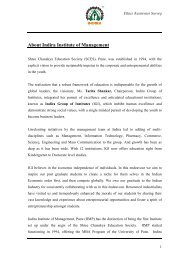IMR JAN 2013 - Indira Institutes
IMR JAN 2013 - Indira Institutes
IMR JAN 2013 - Indira Institutes
Create successful ePaper yourself
Turn your PDF publications into a flip-book with our unique Google optimized e-Paper software.
Green Marketinghas to extend our understanding thatenvironmental consequences (the productsaggregate impact on everyone affected by itsuse) are more important determinants of itsacceptability than either user satisfaction orcorporate profitability (Cracco and Rostenne1971).Recently, Athens Laboratory of Research inMarketing in collaboration with the Center ofSustainability has done a research about thegreen marketing which revealed that aboutninety two percent of customers have afavorable attitude concerning the businessesthat are susceptible on ecological issues(Papadopoulos et al., 2009).Beside,environmentally concerned people whobelieve that pollution is a problem and alsohave a favorable attitude toward greeningenvironment are more inclined to purchasegreen products. Hence, as people becomeaware of environmental problems, theirattitudes and purchase intentions may inturn change. In marketing literaturepurchase intention has been an importantconcept. To forecast the adaptation of newproducts as well as repeat purchases ofexisting ones, most companies usedconsumers purchase intention. Prior studieshave exposed that consumer with intentionsto buy product exhibit higher actual buyingrates than those customers who demonstratethat they have no intention of buying (Brown,2003).D'Souza et al., (2006) reported that generallyperception of green products is negativelyassociated with customer's intention topurchase them if they are of higher prices andlow quality in comparison to traditionalproducts. Consequently, it may be arguedthat there is an expectation on the part ofcustomers that all products offered should beenvironmentally safe without a need tosacrifice quality. Hence, as for as the productquality is concerned, green consumes will notcompromise on it, so businesses mustenhance green product quality as well as focuson environmental benefits of a product, andshare these aspects with customers in order toachieve the recognition in the market(D'Souza., Taghian& Lamb,2006).Schlegelmilch., Bohlen andDiamantopoulos (1996) recommended thatthose organizations aiming to enhancemarket penetration of the existing greenproducts offerings must launch an advertisingcampaign directed at increasing concernabout environmental quality in the consumerbase.Second, organizations make it possible thattheir products perform competitively in otherdimensions. If these two things are achieved,then environmental considerations will nolonger take back seat in purchasing decision.Furthermore, perceived risk is lower in mostpopular brands than for those less wellknown.So customers generally trust on thesebrand and are not ready to compromise onquality. Therefore like non-green alternative,green product must function effectively(Pickett-Baker & Ozaki, 2008).According toTang et al., (2004), a wealth of literatureshows that there is a troublesome gapbetween what consumers says, they will doand how they actually behave. Most of theconsumers say that they choose a productbecause of its environmentally friendlynature, but they do not make actualallocations of dollars in purchases.Therefore, environmental concerns are notthe only reason for the customers to purchaseenvironmentally friendly products, and alsothey do not agree to trade-off other product20 <strong>Indira</strong> Management Review - Jan <strong>2013</strong>








